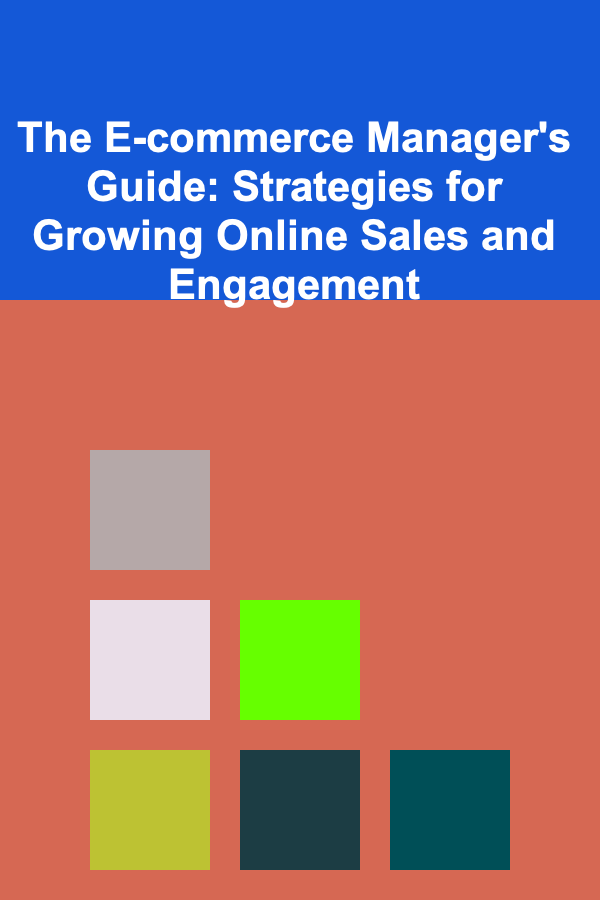
10 Tips for Prioritizing App Features in Your Planning Phase
ebook include PDF & Audio bundle (Micro Guide)
$12.99$5.99
Limited Time Offer! Order within the next:

Building a successful mobile or web application requires more than just excellent design and seamless functionality. One of the most important aspects of app development is determining which features to include in your app, and how to prioritize them. Prioritizing features effectively can make the difference between an app that succeeds and one that fails to gain traction. If you invest too much time in developing features that users don't value or that aren't crucial to the core functionality, you risk spreading your resources too thin and delaying your product launch. Conversely, focusing on the right features can streamline development and provide your users with exactly what they need.
In this article, we will explore 10 essential tips for prioritizing app features during the planning phase. These tips will help guide you through the decision-making process, ensuring that you create an app that meets user needs while staying within budget and time constraints.
Start With a Clear Vision of Your App's Purpose
Before diving into feature prioritization, it is essential to have a clear understanding of the purpose of your app. What problem is your app solving? Who are your target users, and what specific needs do they have? Your app's core functionality should be at the heart of the feature prioritization process. The key to a successful app lies in solving a particular problem effectively.
Define Your Core Features
Think about the features that are necessary to fulfill the primary objective of your app. These core features should be the first items on your priority list. For example, if you're building a fitness app, the primary function might be workout tracking, while additional features like social sharing or health data integration could be secondary.
Starting with a strong vision of the app's purpose will help you focus on features that align with your goals and prevent unnecessary complexity.
Understand Your Target Audience
Knowing your audience is one of the most crucial aspects of feature prioritization. The needs and preferences of your target users will heavily influence the features that should be prioritized. If you're unsure about what features will resonate with your audience, conducting thorough user research can provide valuable insights.
Conduct User Research
Surveys, interviews, focus groups, and beta testing are all effective methods for gathering feedback from potential users. You can also use analytics and insights from similar apps to understand which features users value most. Prioritize features that align with your audience's expectations and solve their problems in a meaningful way.
Create User Personas
Developing user personas can help you visualize your target users' motivations, pain points, and behaviors. These personas will guide your decision-making process, ensuring that the features you prioritize serve the needs of your core audience.
Focus on the Minimum Viable Product (MVP)
In the early stages of development, it's important to focus on creating a Minimum Viable Product (MVP) -- a version of your app with the core features that provide enough value to users to validate your concept. By concentrating on the MVP, you can release your app sooner, get feedback from real users, and iterate on it.
Prioritize Must-Have Features for MVP
Must-have features are those that directly contribute to the app's main functionality. These are the features that will provide the primary value for users. Don't waste time on "nice-to-have" features in the early phases of development. Instead, focus on the essential elements that will enable users to accomplish their goals within the app.
Focusing on an MVP allows you to test your app with real users and ensure that your core features are working before investing in additional features.
Use the MoSCoW Method for Feature Prioritization
The MoSCoW method is a popular prioritization technique that helps you categorize features into four distinct groups based on their importance:
- Must Have: Features that are essential for the app's core functionality.
- Should Have: Important features that add significant value but are not essential for the MVP.
- Could Have: Features that are nice-to-have but not crucial for the first release.
- Won't Have: Features that will not be included in the current development cycle.
This framework will help you organize your feature list and make it easier to decide which features should be prioritized based on their importance and impact.
Analyze the Cost vs. Benefit of Each Feature
Each feature you consider adding to your app will come with a set of costs, both in terms of time and resources. On the other hand, some features may provide more significant benefits in terms of user engagement, retention, and overall satisfaction.
Evaluate Development Effort
For each feature, assess the time, resources, and technical expertise required to develop it. Some features might be easy to implement but offer limited value, while others may be complex but provide a high return on investment. Use this cost-benefit analysis to prioritize features that offer the most value relative to the effort needed to build them.
Consider Long-Term Value
While some features may be easier and quicker to implement, they may not provide long-term value. Prioritize features that will have a lasting impact on your app's success and user engagement. Focus on the ones that will help your app evolve and meet user needs in the future.
Leverage Competitive Analysis
Competitive analysis is an excellent way to identify gaps in the market and evaluate which features are standard in similar apps. By studying the competition, you can identify successful features that your app should also include, as well as areas where you can differentiate your app by offering unique features.
Identify Key Differentiators
Look for features that your competitors have and that users appreciate. However, also look for areas where your app can stand out by offering something different or improved. Differentiating your app in a crowded market can help you attract users and stand out from the competition.
Analyze User Reviews
Pay attention to user reviews and feedback on competing apps. This can give you insight into what users like and dislike about those apps, helping you understand which features should be prioritized or improved in your app.
Think About the Scalability of Features
While it's essential to prioritize features for your initial app launch, you must also think about how your app will scale in the future. Will the features you're prioritizing be sustainable and scalable as your app grows?
Plan for Future Updates
As you plan the development of your app, make sure to leave room for scalability. Features should be designed in a way that allows for future enhancements, additional features, and updates. Scalability ensures that your app can evolve to meet the growing demands of users over time.
Balance Initial Needs with Long-Term Vision
While focusing on core functionality for the MVP is crucial, it's also important to strike a balance between what users need now and what your app may need in the future. Ensure that your architecture is flexible enough to add new features down the line without disrupting the user experience.
Prioritize Features That Enhance User Experience (UX)
A successful app must deliver an excellent user experience. Features that make the app more intuitive, easy to use, and enjoyable can significantly enhance its chances of success. While functionality is essential, UX design should never be overlooked when prioritizing features.
Focus on Simplicity and Usability
Simplicity is a key factor in user retention. Features that enhance usability, such as intuitive navigation, seamless onboarding, and streamlined workflows, should be prioritized. Avoid adding complex features that could clutter the interface or make the app harder to use.
Collect Feedback on UX
Gather feedback from users early in the development process to understand which features contribute to a better UX. User testing and beta trials can provide valuable insights into which features users find most helpful and enjoyable.
Stay Flexible and Open to Iteration
Feature prioritization isn't a one-time task; it should be an ongoing process that evolves based on user feedback, testing, and changing market conditions. During the development and after launch, you will likely need to adjust your priorities as you gain new insights.
Be Ready to Pivot
If user feedback reveals that a particular feature is not well-received or that users are asking for a different functionality, be prepared to pivot. Flexibility in your planning phase will help you adapt to new information and make data-driven decisions.
Continuous Improvement
Feature prioritization doesn't stop after launch. As your app grows and users engage with it, you'll gather more insights that should inform future updates. Keep an eye on trends, listen to your users, and continue to evolve your app based on real-world feedback.
Use Agile Methodology for Iterative Development
Agile development is an iterative approach that allows you to develop and release features in smaller chunks rather than waiting for a complete product to be finished. This methodology allows for flexibility and quicker responses to user needs, making it ideal for app development.
Break Features into Smaller Tasks
Instead of developing large, complex features all at once, break them down into smaller, more manageable tasks that can be developed and released in stages. This allows you to deliver incremental updates and improve your app progressively.
Prioritize Based on User Feedback
Agile methodology encourages continuous feedback and iteration. Prioritize features that users request or that solve problems more urgently. By continuously adapting based on feedback, you ensure that your app evolves in a way that truly benefits users.
Conclusion
Prioritizing app features during the planning phase is a crucial step in the app development process. By clearly understanding your app's purpose, analyzing user needs, and leveraging methods like the MoSCoW framework and competitive analysis, you can ensure that you focus on features that will provide the most value to your users. At the same time, it's essential to stay flexible, iterate based on feedback, and plan for future scalability. By keeping these 10 tips in mind, you'll be well-equipped to make thoughtful, strategic decisions about which features to prioritize, setting your app up for success in the competitive marketplace.
Reading More From Our Other Websites
- [Home Party Planning 101] How to Set Up an Efficient and Stylish Home Bar for Your Party
- [Rock Climbing Tip 101] Best Gear Recommendations for Cold‑Weather Ice‑Climbing Mixed with Rock Sections
- [Biking 101] The Benefits of Bike Commuting: Why You Should Ride to Work
- [Simple Life Tip 101] How to Adopt a Minimalist Mindset Through Daily Gratitude Practices
- [Home Security 101] How to Safeguard Your Garage and Its Contents
- [Home Budget 101] How to Create a Savings Plan for Home Renovations
- [Organization Tip 101] How to Use Wall Art for Functional Organization
- [Organization Tip 101] Timeless Victorian Home Exterior Paint Color Combinations
- [Personal Finance Management 101] How to Use the Debt Snowball Method to Pay Off Debt
- [Organization Tip 101] How to Organize Your Family's Wardrobe for Easy Mornings

Beyond Numbers: The Art of Analytical Decision Making in Operations
Read More
How To Cope with Depression: Psychological Strategies
Read More
How to Design a Grant Reporting Checklist for Environmental Grants
Read More
The E-commerce Manager's Guide: Strategies for Growing Online Sales and Engagement
Read More
How To Choose the Right Milk for Your Coffee Drinks
Read More
Choosing the Right Broom and Dustpan for Different Surfaces: A Comprehensive Guide
Read MoreOther Products

Beyond Numbers: The Art of Analytical Decision Making in Operations
Read More
How To Cope with Depression: Psychological Strategies
Read More
How to Design a Grant Reporting Checklist for Environmental Grants
Read More
The E-commerce Manager's Guide: Strategies for Growing Online Sales and Engagement
Read More
How To Choose the Right Milk for Your Coffee Drinks
Read More